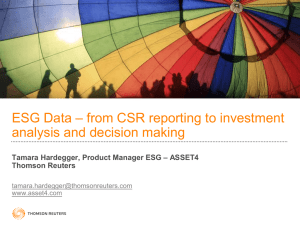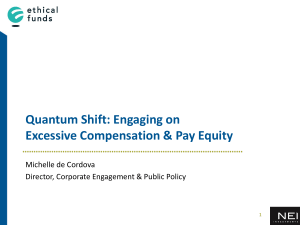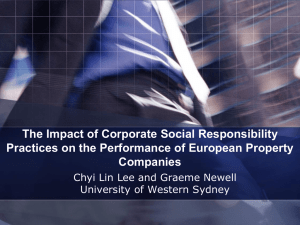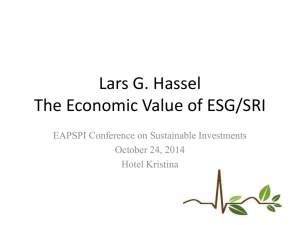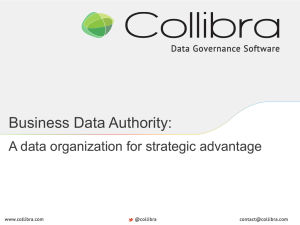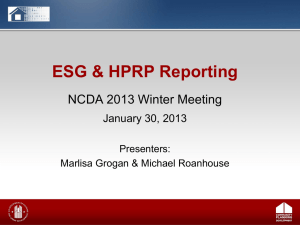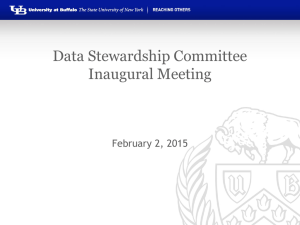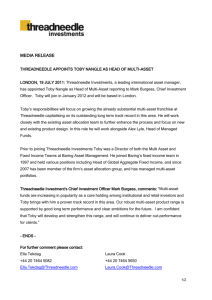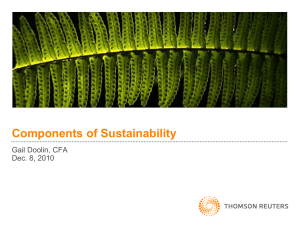Governance & Responsible Investment
advertisement
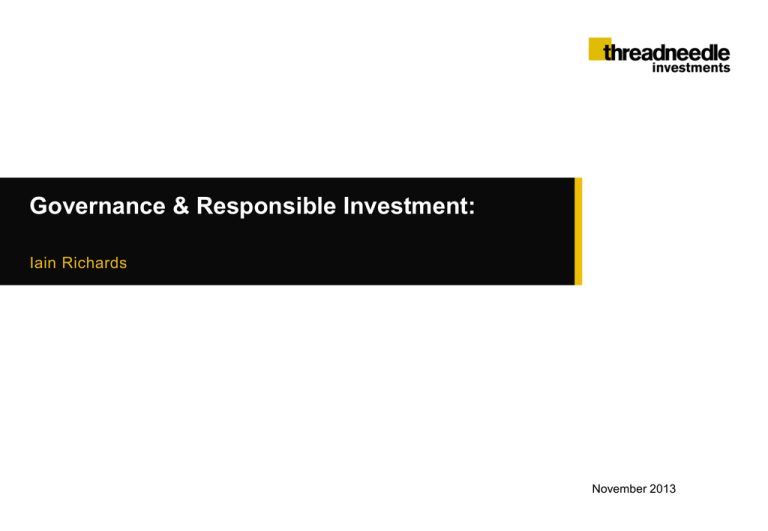
Governance & Responsible Investment: Iain Richards November 2013 Agenda What is our approach to Stewardship (i.e. of the Fund’s investments) and the intergration of Environmental, Social & Governance (ESG) issues? What does that mean in practice? 1 What is our approach? 1 Our Philosophy on Stewardship & Responsible Investment Core to our investment philosophy is the belief that well governed companies are better positioned to manage the risks and challenges inherent in business and to capture opportunities that help deliver sustainable growth and returns for our clients overtime. Effective stewardship and engagement will therefore benefit companies, our clients and the economy as a whole. Our fund managers, analysts and Governance and Responsible Investment team work collaboratively to monitor and engage with the companies we invest in, with a view to understanding the dynamics, opportunities and risks inherent in the businesses and to protect the interests of our clients and the capital they have invested. Integrating Environmental, Social & Governance analysis into the investment process is one aspect of this. In addition to exercising our stewardship and monitoring responsibilities, this approach enables us to consider risks and opportunities of existing and prospective investments, which may not be captured by conventional analysis. ESG issues are therefore one aspect of how we look to build a ‘perspective advantage’ and ensure client portfolios benefit from our best ideas. 3 Industry collaboration and initiatives Signatories to: The UK Stewardship Code in 2010 The UN backed Principles for Responsible Investment (PRI) since launch in 2006 The Extractive Industries Transparency Initiative (EITI) since 2006 The Carbon Disclosure Project (CDP) carbon, water and forestry since 2005, 2009, 2010 Active members of: The Association of British Insurers (ABI) since 1998 United Kingdom Sustainable Investment and Finance Association (UKSIF) since 1998 The European Social Investment Forum (EUROSIF) since 2008 The Asian Corporate Governance Association (ACGA) since 2010 The International Corporate Governance Network (ICGN) since 2011 Global Investors Governance Forum (GIGN) since 2012 UK Corporate Governance Forum (CGF) since 2012 4 How we explain our approach and set out our stall Describes how we apply the seven principles of the Stewardship Code and our approach for clients, e.g. in relation to company monitoring, engagement and collaboration with other investors. Sets out our approach to integrating Environmental, Social and Governance (ESG) issues in practice on behalf of our clients. Practical focus on how integration within the investment process works in practice. Sets out our headline policy and views on key principles of real world corporate governance (i.e. not just Code governance) that we draw on in our engagement and in making our voting decisions. 5 Develops and explains the nature, scope and approach to ESG analysis and to the Key Performance Indicators (KPIs) that consider to be particularly relevant, in an investment context. How does it work in practice? 2 Scope and capabilities Responsible Investment Strategy Definition Threadneedle capabilities/ preferences Applicable Fund strategies Integration All equity funds and to some extent corporate debt and commodities Types ESG Integration ESG is incorporated into investment analyses and decision making Engagement Active voting and engagement in investee companies Engagement All equity funds Negative Screening Avoidance of investment in targeted companies, industries and countries Ethical or sector screen All equity, bond and commodity funds Best in class All equity funds Thematic investments Property fund (Low Carbon Work Place Fund) Impact Investment UK Social Bond Fund Positive Screening Seeking to invest in companies with a commitment to responsible business practices or that produce positive products and/or services 7 Threadneedle equity investment process including ESG Idea generation Macro and themes ESG topics form part of thematic research and ideas Company meetings Where appropriate, company meetings include GRI team and/or ESG questions Equity teams and other Investment professionals GRI team are part of the investment professional team Research / debate Implementation Stock analysis • Proprietary ESG stock analysis included in stock reviews Portfolio construction • ESG included in global sector discussion • Ratings: MSCI ESG research ratings (CCC to AAA) used as a flag to initiate and focus research Risk management 8 Monitoring ESG analytics used to review portfolios on thematic issues for information purposes Continuous monitoring and engagement on core holdings Company Ratings While we use and talk a lot about ESG ratings (we use MSCI ratings) in a lot in our work, in practice we use a variety of ratings and screening exercises to check companies across our investment universe: ESG Ratings, controversy ratings, accounting ratings and other ad hoc screens. One example of this is using accounting screens to rate the potential level priority that needs to be given to companies, i.e. an additional objective look at those that merit a more detailed review and attention given they have characteristics that could be associated with accounting problems (restatements, regulatory action, fraud): • Revenue Recognition – is accelerating top-line growth being driven by premature, non-recurring or fictitious revenue activity? • Expense Recognition – are expenses being deferred/delayed to improve margins through the capitalisation or amortisation of expenses? • Asset-Liability Valuation – is there a risk that assets (receivables) are being over-valued, could liabilities (payables) be under-stated, is there a risk that reserves are being manipulated (pensions)? • High-risk Events – Are events that are know can be associated with accounting issues happening, e.g. M&A, divestitures, restructurings, share repurchases, equity financing etc • Governance – management changes, compensation, financial reporting, insider trading and other governance issues are key fraud indicators • Default risk – a combination of the above factors, liquidity and leverage factors and the Merton Distance to default model. 9 ESG stock review process Our proprietary research is a cross between best-in-class and an absolute consideration of a company We look for all aspects of ESG and transparent KPIs linked to financial performance SWOT analysis and overall assessment of low, medium or high ESG risk using various inputs The review includes questions for future engagement 10 Thematic ESG research - Water We aren’t able to publish our investment research, but do try and share the flavour of some of it in our Quarterly reports: Currently, the water sector represents approximately 1% of world GDP (source OECD). However, the “true cost” of water is often underestimated. The actual financial risk is realised when the excessive use or discharge of water is coupled with regulatory or social sanctions which results in a change to these relative economics both on a macro and a corporate scale. Water is a local issue and the problems and particularities vary substantially between different regions. With urbanisation and population growth, individuals, agriculture and energy water use is rising rapidly. Aggregate world water demand is expected to grow by 55% by 2050. Working with the CDP water initiative (survey of 185 global companies) we find that 68% of respondents in 2012 identified water as a material business risk. Illustrative Risks: Industries that are particularly affected include: consumer staples (food); energy and extractives (oil and gas); utilities and consumer discretionary (textiles). Interestingly, many of the major drivers of these industries are closely linked to China. China relies on 77% of its energy from coal which is the most water intensive energy sector, China produces nearly 40% of the world’s clothing and China is one of the major consumers of food with the world’s largest population of 1.3bn people. Greater regulation and scrutiny as well as a very real problem of scarcity have led these sectors to be increasingly concerned about how they are managing and using water. Illustrative Opportunities: These areas of risk pose an opportunity for the solutions providers. The water market has been estimated at USD 400bn by Global Water Intelligence and opportunities exist in a very wide range of sectors with different characteristics including IT/tech, utilities and industrials: • • • • • • Water supply associated with big spend infrastructure renewal and supply projects - opportunity for pipes and parts Water related IT - water reuse and in metering and billing of customers. Providers of desalination solutions and membranes in industrial process water Mobile solutions for water supply and treatment as the uneven distribution is often the major reason for scarcity Energy efficiency and optimisation of water products is a key emphasis for customers and product evolution. Ballast water treatment. 11 Stewardship & engagement 12 Proxy voting policy and procedures Active promoters of good governance and practice proxy voting globally across 50 markets through online platform provided by ISS Vote execution is outsourced to our back office Draw on best practice standards (e.g. UK Corporate Governance Code) but set out our own stall on what we consider important Regularly engage with companies with focus on controversial issues Open discussion with fund managers and analysts Report internally and externally on proxy voting activities Meeting ID Review Ballot Engage Decision Instruction 13 Vote Execution Confirm Vote Follow up with company Proxy voting – where’s our focus (year to date) Resolutions Voted Against Management 50% 45% 44% 40% 35% 30% 25% 20% 19% 15% 15% 9% 10% 9% 5% 2% 1% Reorganisation and Mergers Anti-takeover Related 0% Director Related Remuneration Capitalisation Other Business 14 Shareholder Resolutions Case studies 3 Flotations (IPOs) So what goes into looking at IPOs: Point fund manager coordinates and pulls together our assessment of: • • • • • • • • What the business does It’s business model It’s growth drivers and markets What can go wrong Governance & risk issues The financial analysis Valuation Price ranges Multiple meetings can be held with management. External expert views can be sought The investment case is debated internally. Approach to and strategy for subscribing is designed. Source: Bloomberg 16 Mergers & Acquisitions Shareholder Threadneedle slams recommended Xstrata-Glencore deal LONDON, 1 Oct 2012 (Reuters) - Threadneedle Investments, one of the 25 largest shareholders in Xstrata, said on Monday it remains firmly opposed to the recommended merger with trader Glencore, which it says gives away the miner's future earnings "on the cheap". 20% 15% 10% 5% Xstrata Glencore 0% In a letter sent to the board of Xstrata, Iain Richards, head of governance and responsible investment at Threadneedle, described the process through which the deal has emerged and evolved as "deeply disappointing", and making "no sense" for its clients. 2013 2014 2015 2016 2017 -5% -10% -15% "The apparent target fixation on doing a deal has, to our minds, been at the expense of proper consideration being given to the quality and value imbedded in Xstrata and its good prospects as a standalone business," Richards said. 17 ESG Engagement – company specific (G4S) G4S is one of the largest service companies in the UK with a turnover of more than £1.2 billion and 40,000 employees. It’s 6,000 customers, include the majority of UK Government departments and many schools and community health centres. However, the overall approach to corporate responsibility at G4S fell way below industry standards and it had the lowest ESG rating we use ‘CCC’. Just some of the many issues included: • • • 29 fatalities in 2013 (to end September), 59 in 2012 and 74 in 2011. The failed Olympics contract cost the company £100million pounds Overcharging and inappropriate interpretation of contracts for the UK ministry of defence. Its fall from grace, however, provides a new opportunity to take an interest and turn things around. Although previously we did not invest in the firm we are now taking an interest Shareholder focus and engagement doesn’t end once you change a CEO (Ashley Almanza replaced Nick Buckles, May 2013). The company is in a period of change (new management, new board risk committee, expansion of country-reviews, a new internal risk team and an overhaul of its approach to health and safety) and over the last three months we have met them four times and had 2 additional conference calls. 18 Source: Bloomberg ESG Engagement – Thematic (Bangladesh) Threadneedle is one of the signatories of a collaborative investor statement focused on Bangladesh, alongside approximately 202 global investor signatories representing $3.1 trillion of assets following the Rana Plaza building collapse. In following up to the investor statement, the collective group of signatories are working together to follow up on individual efforts and encourage wider take-up of the Bangladesh Accord and to achieve better disclosure by companies in this regard given that it can be a material investment risk. During just the third quarter over 200 factories were closed due to strikes from employees wanting wage increases and while companies are usually able to divert sourcing, it does pose a business continuity risk. Furthermore there are continued incidents of factory collapse yet there remains limited agreement on the individual cost of companies from signing up to the accord. In total the group of companies have pledged $60million over 5 years. This could represent substantial change for the industry and while we support the initiative we are mindful of cost inflation in the sector. We are hopeful that coupled with improved productivity better practices should improve shareholder value in the long run. Just signing up to a statement of support for the Bangladesh Accord is not our way. Over the third quarter of 2013 we were engaging with 13 of our holdings in the clothing retail space. Our approach involved both clarifying basic issues, such as their exposures and where their suppliers are located, how human rights and labour issues are discussed at the board and how the company solves labour disputes in their supply chain, then following up with subsequent calls and meetings. While some of the retailers, notably Inditex and M&S are at the forefront of managing this issue, many of the companies have very limited disclosure and management of supply chain human rights concerns. Interestingly, most of these companies do not make the location or number of suppliers transparent to investors and some companies admit to not having a good overview of the reach of their supply chain beyond their local sourcing. As such it would seem that signing up to the Accord needs to be a progressive step. As investors we recognise that general supply chain management and disclosure is essential to thoroughly assess wider investment risk. 19 Hot topic: Executive Pay 4 The New UK Framework For Reporting On Executive Pay From October 2013, listed UK companies have to present shareholders with a new format of reporting on remuneration 21 Where have we got to on FTSE100 CEO pay? £5,000,000 Total Remuneration Awarded and FTSE 100 Index (excludes dividends) £4,500,000 £4,000,000 LTIP EV £3,500,000 Otpions EV FTSE 100 Index at 31 Dec Def Bonus £3,000,000 Cash Bonus £2,500,000 Other Remuneration Pension £2,000,000 Salary FTSE100 £1,500,000 £1,000,000 5,896 6,268 6,296 5,618 5,165 4,391 6,457 5,412 4,814 6,014 5,700 5,898 6,559 4,562 3,567 £500,000 £0 1998 6,221 1999 2000 2001 2002 2003 2004 2005 Source: MM&K/Manifest 22 2006 2007 2008 2009 2010 2011 2012 latest data 2012/13 Pay differentials – the figure companies really didn’t want to publish… ….. and lobbied hard against Median Full time Employee Earnings 2 CEO as Multiple of Average Employee £2,599,551 £22,518 115 x 2004 £2,786,143 £23,512 118 x 2005 £3,087,028 £24,399 127 x 2006 £3,304,533 £24,909 133 x 2007 £3,308,814 £25,629 129 x 2008 £3,876,921 £26,826 145 x 2009 £3,958,000 £27,509 144 x 2010 £3,895,000 £27,590 141 x 2011 £4,245,000 £27,817 152 x 2012 £4,771,777 £28,208 169 x June 2013 £4,534,228 [£28,502] 159 x Year CEO Total Remuneration 1 2003 1. MM&K/Manifest 2. ONS data, adjusted to include employer pension contributions @ 6.6% 23 …. And don’t forget the pensions The government’s employer rate for auto-enrolment starts from 1% The Pensions Quality Mark only requires a minimum employer contribution of 6% The average employer contribution rate is 6.6% For executives the picture is as follows Source: Lane Clarke & Peacock 24 How Concerned Are Investors At Large About Pay? % of FTSE 100 Companies 96% of FTSE 100 companies received more than 80% voting support in 2013 (to Sept), compared with 91% in 2012 Source: Deloitte 25 The Remuneration Report – how do we asses it? There are an array of guidelines and checklists on executive pay, but at the end of the day what does an assessment come down to? For us it is based around whether I consider the arrangements to be: 1. Clear, simple and understandable 2. Balanced and proportionate – focus here includes structure, opportunity, quantum and differentials (such as the broader market, employees generally, inflation etc.) 3. Aligned with the long-term strategy – e.g. related Key Performance Indicators (KPIs), risk management discipline etc 4. Incorporating robust performance in long-term incentives – At least 3 years forward looking and subsequent deferrals (both bonuses and long-term incentives) that are at risk (malus or clawback) 5. Delivering outcomes that reflect value creation & the outcome for our clients (the key issue) 6. Structured to avoid pay for failure 26 Conclusion We don’t make a big public ‘song & dance’ of it, but responsible investment is part of what we do; part of how we aim to look after our client’s assets. It builds on our collaborative model and is integrated in the investment process from idea generation and analysis to monitoring and engaging with the companies we invest in. We try and give a clear insight into our approach and work in this area, both through our policies, our quarterly reporting and in meetings and briefings with our clients. 27 Important information This material is for information only and does not constitute an offer or solicitation of an order to buy or sell any securities or other financial instruments, or to provide investment advice or services. This document is a marketing communication. The research and analysis included in this document have not been prepared in accordance with the legal requirements designed to promote its independence and have been produced by Threadneedle Investments for its own investment management activities, may have been acted upon prior to publication and is made available here incidentally. Any opinions expressed are made as at the date of publication but are subject to change without notice and should not be seen as investment advice. Information obtained from external sources is believed to be reliable but its accuracy or completeness cannot be guaranteed. This presentation and its contents are confidential and proprietary. The information provided in this presentation is for the sole use of those attending the presentation. It may not be reproduced in any form or passed on to any third party without the express written permission of Threadneedle Investments. This presentation is the property of Threadneedle Investments and must be returned upon request. Issued by Threadneedle Asset Management Limited. Registered in England and Wales, Registered No. 573204, 60 St Mary Axe, London EC3A 8JQ, United Kingdom. Authorised and regulated in the UK by the Financial Conduct Authority Threadneedle Investments is a brand name and both the Threadneedle Investments name and logo are trademarks or registered trademarks of the Threadneedle group of companies. 28
